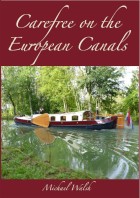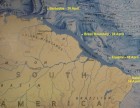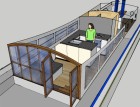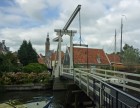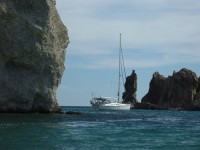Sequitur
Michael & Edi have headed out on a slow, thorough exploration of the globe.
| Vessel Name: | Sequitur and Zonder Zorg |
| Vessel Make/Model: | 2007 Hunter 49 and 1908 Wildschut Skûtsje |
| Hailing Port: | Vancouver, Canada |
| Crew: | Michael Walsh & Edi Gelin |
| About: | For our current location click, on Map & Tracking, then on the Google Earth logo. |
| Extra: | Follow us on Twitter: Follow @YachtSequitur |
| Social: |
13 January 2014
Another New Book Released
I am delighted to announce that my new book: Carefree on the European Canals is now in print and is available on Amazon.com, Amazon.ca [...]
26 April 2013
New Book Released
The proof copy of my new book arrived by courier today. I have approved it and it is now listed on Amazon for pre-order, with a publication date of 30 April. It is a rather large book at 680 pages in an 8.5 by 11 inch format with 315,000 words illustrated by over 2400 colour photos, charts and maps. [...]
24 April 2013
One Year Out of Brazil
One year ago today we sailed Sequitur out of Brazil after enduring more than six weeks in the least-friendly country that we had experienced during our three-year voyage. In the early evening of 24 April 2012 we crossed the line on the chart dividing Brazil from French Guyana and breathed a huge sigh [...]
27 October 2012 | Harlingen, Friesland
Planing a Metamorphosis
We have added a new post to the Zonder Zorg blog at: Planing a Metamorphosis.
29 September 2012 | Sneek, Netherlands
Onward to Friesland
We have arrived in Friesland and have added a new post to the skûtsje's blog at: Onward to Friesland
19 September 2012 | Hoorn, Netherlands
North From Aalsmeer
We have moved northward from Aalsmeer and I have added two new posts: Heading North From Aalsmeer and North From Amsterdam
13 September 2012 | Aalsmeer, Netherlands
Taking Possession
We are back in the Netherlands, and I have added some new posts to the ZonderZorg blog at: Taking Possession and Settling-In and Making Plans
20 August 2012 | Sequitur: St Augustine, USA - Michael & Edi: Vancouver, Canada - Nieuwe Zorg: Aalsmeer, Netherlands
Added a New Website
We have added a new website: Skûtsje ZonderZorg. Zonder zorg in Dutch means without worry. Our intention with the site is to provide a place to share some of the history, geography and culture of the skûtsje as we discover it. We will also use this place to document [...]
11 August 2012 | Sequitur: St Augustine, USA - Michael & Edi: Vancouver, Canada - Nieuwe Zorg: Aalsmeer, Netherlands
Still More Skûtsje History
We continued to attempt to track-down Douwe Albert Visser, who was the owner of Nieuwe Zorg in 1941 when she was re-registered. One of the problems we repeatedly encountered in our online searches was the effect of currently having Albert Visser and two Douwe Vissers as very competitive skûtsje racers, [...]
10 August 2012 | Sequitur: St Augustine, USA - Michael & Edi: Vancouver, Canada - Nieuwe Zorg: Aalsmeer, Netherlands
Some More Skûtsje History
While I was researching the history of Nieuwe Zorg, I finally found her first registration details obscured by an apparent typographical error in a transcribed online spreadsheet. She was listed as having been built in 1901 instead of 1908. I emailed the webmaster of the [...]
To The Falklands
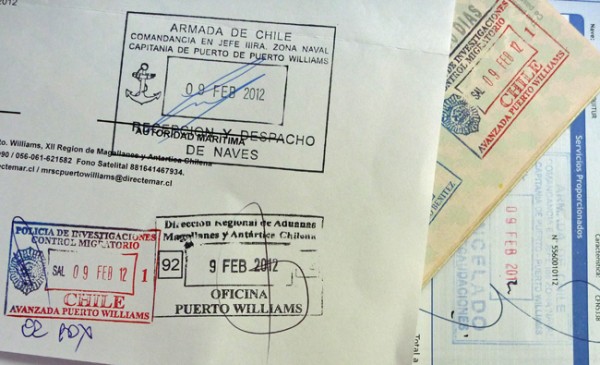
We prepared Sequitur for sea, and at 1330 headed over to the Capitan de Puerto. The Armada personnel were quick and efficient in preparing the zarpe, the Customs officer quickly scanned and stamped our documents, the Migracion officer stamped our passports cheerfully and wished us safe navigation. This left only the civil servant plug-in-the works who does the financial part of the process. He dawdled, had tea, did useless things, read manuals, dug in files and tried to pretend he was busy. We have long ago learned that to push this type of person leads only to longer delays, and likely to a fine-tooth-comb treatment. We exercised our patience as he managed to stretch-out the process for over an hour and a half and finally came-up with an invoice for 49,500 Pesos, obviously disappointed he could find no other fees to charge us.

It was nearly 1600 by the time we got back to Micalvi and I went into the bar to find Miguel and pay for our moorage and electricity. We had spent two days alongside before heading to the Horn and another six waiting for a weather window to head north. The charges came to US$168, which I paid with our last 66,900 Chilean Pesos, our leftover 22 Argentine Pesos, and our last US$23. Other than a few coins, we were out of all American money, North, Central and South. It was a good time to head to another continent.

We were third-out in a raft of six in the middle of the three rafts on Micalvi's west side. Ahead of us was another raft of six, and the one astern had four boats. We were dead centre of the sixteen boats, with a cat's cradle of lines strung from each to counter the unpredictable wind shifts, the rachas and the williwaws. We needed the cooperation of seven other boats to dig ourselves out.

Before we headed over for our zarpe, we had informed the skippers of the boats astern and the one outboard us of out departure intentions. The two additional boats outboard us had come in while we were uselessly delayed at the Capitania and their skippers were ashore doing paperwork. The boat directly astern of us, the New Zealand ketch, Victoria was ready to head to Puerto Toro to stage for a run to the Horn. They told us they would be leaving after tea. Finally at 1706 we slipped and headed out, a little over two hours later than we had planned.

Our zarpe said Cape Town, but we were headed to the Falklands. The Argentine government is again turning-up the heat on their claims to the Malvinas (Falklands), and we needed to keep all mention of the Falklands from all of our communications. As we motor-sailed out the Beagle Channel, we religiously stayed in Chilean waters, taking a considerably longer route, and then we went out to clearly beyond the Argentine 12-mile Territorial Waters line before heading north of east along the south coasts of Isla Tierra del Fuego and Isla de los Estados.

The sunset at 2122 had found us turning southeast around the northeast corner of Isla Picton. Four minutes later the full moon had theoretically risen in the overcast sky. The wind was southeast at 10 knots as we motored directly into it at 7 knots. It began raining. At 0600, shortly after sunrise on Friday morning it was still raining. The wind had gone around to our starboard quarter and was assisting us along a bit with its 10 knots. We continued motor-sailing into a cold, dank day. By midmorning the rain had stopped and the clouds had nearly all moved off to the east, or had dissipated. It warmed rapidly in the cockpit, and by the time Edi had brought brunch up, I had stripped-off nine pieces of clothing, and was down to only two layers of fleece on top and insulated pants on the bottom, plus wool socks inside low shoes.

Friday noon we were 193º - 20.4 miles of the southeast cape of Isla de los Estados, the last piece of Argentina. We had made 132.3 miles in just under 19 hours, almost exactly 7 knots in adverse tides and winds. Through the middle of the day as we came to our CPA on Estados, we watched an Argentine patrol vessel shadowing us on its 12-mile limit. It continued paralleling us until apparently convinced we wouldn't enter their waters.

We were also being watched by hundreds of albatross soaring in the wind currents above the waves. These were mostly black browed and royal, but also there was a good number of wandering albatross. We also saw dozens of Antarctic fulmars, which braved very close to the boat.

We continued to monitor the sky and the barometer for changes that would signal the deepening of the depression northwest of the Falklands. On Friday the barometer rose above 1000 for the first time in over two weeks and made it to 1005.4 at 0700 on Saturday, before beginning a slowly undulating decline. On Saturday afternoon Edi spotted a formation in the clouds, and we wondered whether it was our weather window.
On Saturday afternoon the winds veered to northeast and increased to over 20 knots and our speed was down to 5.5 as we motored directly into it. At 1706 our 24-hour run was 154 miles, down from our first 24-hour run of 170.3. At 1945, as we were approaching Sea Lion Islands off the southwest corner of the Falklands, the engine died. I went below and switched the Racor primary filter from the port to the starboard one. I restarted the engine and we continued for another 10 minutes, then died again. I rolled-out the staysail and half the main and we sailed east-southeast while I went below to change to a fresh port filter. At 2209 in sloppy and confused seas, I completed the filter change, primed the system and restarted the engine. We resumed our motoring northeastward, directly into the wind. We still had 75 miles to go to make Stanley. At 7.5 knots we would be there shortly after 0800 Sunday morning, well before the blow forecast to begin in the late afternoon. Our progress slowed as the tide turned and at midnight we were down to 4.5 knots at with turns for 8.

I looked at the gribs again and at the cyclone predicted to pass over Stanley at 1800. On my iPad I plotted a dozen-or-so anchorages along the coast, which would offer some protection from the predicted 50+ winds and we pressed on, making the best speed possible against the tide and wind.
At midnight the barometer was at 989.8, at 0700 Sunday it was down to 982.9 and further down to 979.1 at 0900, when the wind was northwest 18 to 22 and assisting us along a bit. At 1025 we were hit by a squall with gusts to 42 and heavy rain. At 1113 another more gentle squall passed over with winds to 33. At 1247 a more violent one hit us with 45 to 50 knot winds. I headed north toward Port Fitzroy.

At 1413 we were about 4 miles from the entrance to Fitzroy when sustained winds over 50 knots and rapidly building seas made progress difficult. Thoughts of approaching an increasingly lee shore as the wind backed made me reexamine the situation. At 1430 I rolled-in the last hanky of the main and put our stern to the storm to run with it to seaward under power.

At 1440 I decided to turn southward into the troughs, shut-down the engine and lay a-hull under bare poles. I had pointed our bows south incase I needed to use the engine to gain some southings to clear Wolf Rocks to the east-northeast of us. I watched our drift on the cockpit chart-plotter and was pleased with its direction.

We also watched the inclinometer jam-up a couple of times against the stops at 60º, but never could get a camera in position to record more than 43º. We were hit by a few breaking waves, and Sequitur took them in stride. I thought of launching the Jordan series drogue, but realized that we were just fine without.
We went below and cocooned in the rather more peaceful salon. From the chart-plotter there I monitored our drift east-northeast, and saw that if the wind maintained its direction, we should clear Wolf Rocks. I set-up a plot on the iPad to track our drift, and we laid down on the main salon couches to relax and watch the storm happen. We Called FishOps in Stanley on VHF and reported our situation, telling them we were comfortable, safe and in no danger. The watchkeeper told us they had been monitoring us on AIS and would maintain a watch.

The port sidelight in the salon was looking bottom-ward a few times as breakers hit our starboard beam. Overhead, through the skylights and hatches we watched as great depths of green water sluiced over the decks. We remained dressed, with boots on and covered ourselves with duvets and napped.

I awoke at least every half hour to monitor the situation on the iPad beside me on the settee, and to put on an hourly fix. At 1740 we drifted past Wolf Rock, clear by 3.1 miles and continued to seaward. I told Edi that the next piece of land to the east of us was the west coast of Chile, a circumnavigation away. We relaxed further and slept more soundly.
By 2200 the winds had abated to the low 40s and we were rather hungry, not having eaten since breakfast. As Sequitur rolled in the troughs, I juggled a Lock-and-Lock of frozen sauce Bolognese in the microwave to defrost, and then did the same with a Zip-Lock of basmati rice. Our usual routine is to make extra portions when we cook, and freeze them in one-meal batches for times when it is difficult to be more creative in the galley. This was one of those times. I heated the Bolognese in the wok as the stove gimbals hit the stops, added a can of sliced mushrooms, a can of black beans and finally the rice. We wedged ourselves into the couches and spooned comfort food from huge China Town rice bowls.

Reenergized by the hot food, we prepared to get underway again and see if we could make Stanley. At 2300 we flashed-up the Yanmar and began motoring westward, back toward the Falklands. We had drifted nearly 25 miles and had 19 miles to go to make it into Stanley Harbour. The seas were initially 4 to 5 metres and rather confused, and we were able to make 3.5 knots directly into them and into the 40-knot winds. By 0230 we had gained some lee from the high winds and seas and were in more manageable conditions.

By 0300 we were in comparatively pleasant waters, we had found the Blanco Bay sector light and were on its line. We easily found the red transit lights through the narrows and then headed up-harbour into the 35 knot wind to a spot in front of the public wharf, where at 0340 on Monday the 13th we came to 35 metres on the Rocna in 8 metres of water. We went back below to our settees and went to sleep until nearly noon. We were a tad tired, but we were in the Falklands.

